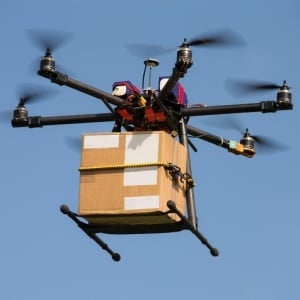
Drones have been proposed for some pretty mundane uses, such as delivering pizzas or packages, but new research suggests the high-flying machines could be used to swoop in and save lives.
Swedish researchers think drones can quickly deliver defibrillators to someone whose heart has suddenly stopped beating.
The study was published as a research letter in the Journal of the American Medical Association.
Faster than emergency services
"Each minute that passes after a sudden cardiac arrest decreases the chance of survival by approximately 10%," explained lead investigator Andreas Claesson. He's a paramedic with the Center for Resuscitation Science at the Karolinska Institute in Stockholm.
"In rural areas, a drone carrying an AED [automated external defibrillator] could arrive far ahead – meaning 16 minutes [faster] – of emergency medical services," he said.
And that, Claesson said, could "potentially save lives through earlier defibrillation as carried out by bystanders onsite".
This is not a new idea, and in previous studies researchers have concluded that sending drones to deliver vaccines in low- and middle-income countries would be cheaper and quicker than by land-based vehicles.
According to a Health24 article, in Papua New Guinea, drones are being used to transport medical supplies to solve the problem of crocodile-infested rivers, choppy seas and a lack of proper roads.
Cardiac arrest outside a hospital
When someone in a hospital has a sudden cardiac arrest, trained staff can immediately use a life-saving defibrillator. These machines electrically shock the heart in the hope of restoring a normal beating rhythm.
If sudden cardiac arrest happens outside a hospital, emergency teams must battle traffic and distance to deliver defibrillators to those in need.
But the new study suggests that drones might be able to outpace ambulances by speeding unobstructed over clogged roads and long distances to drop an easy-to-use AED into the hands of people already on location.
Portable and usable by bystanders
Only about 10% of cardiac arrest patients pull through. But a super-fast application of CPR can roughly double or even triple a patient's survival prospects, Claesson said.
The challenge has been connecting patients with trained emergency medical services (EMS) professionals in a timely way, Claesson noted, particularly in rural settings where hospitals and AED equipment are often far-flung. This means that "the people in the vicinity of a cardiac arrest are crucial for survival", because they're essentially the first caregivers.
It's with that scenario in mind that the study set out to see if delivering defibrillators by drone would be effective, according to Claesson.
The US National Heart, Lung, and Blood Institute noted that AEDs are specially designed to be portable and usable by untrained bystanders.
The devices are often found in public facilities, such as sports venues, malls and airports.
Still, they're not always in reach. And that means that when a cardiac arrest happens, many Americans – particularly those in remote areas – must call 911.
Delivery in five minutes
For the study, the Swedish research team outfitted a Stockholm-area fire station with a drone developed by the Swedish Transportation Agency. The devices were fully equipped with an AED, GPS, autopilot software, and a high-definition camera.
In 2016, investigators conducted 18 remotely operated simulated drone deliveries. The locations were within a roughly 6-mile radius of the fire station. Actual patients had experienced a cardiac arrest at each location sometime between 2006 and 2014.
The drone delivered the AED in just over five minutes. That compared with an average standard EMS delivery time of 22 minutes. That meant a delivery savings of almost 16 minutes, according to the report.
The average time to take-off was just three seconds after ordering a drone dispatch. For EMS, the average call to dispatch time was three minutes, the study found.
Because no actual patients were on hand and there was a second drone pilot on hand at the landing site, Claesson said his team doesn't know how well the bystanders might interact with the drone or the AED. He also noted that aviation regulations will clearly have to be considered if such a system was ever implemented.
American College of Emergency Physicians spokesperson Dr Leigh Vinocur serves as medical director of the urgent care division at MedStar Health in Columbia, USA.
'Clinically significant' speed
She pointed out that the current investigation is "very small", and didn't account for real-world variables that could affect drone delivery, such as bad weather.
Yet Vinocur nonetheless views the theoretical prospect of drone-delivered defibrillators as "a great idea with a lot of potential".
"We know that out-of-hospital cardiac arrest has a high mortality, that improves with both bystander CPR and early defibrillation with AED," Vinocur said.
But Vinocur said some communities have limited nearby access to AEDs.
"Not only do greater distances have to be traversed to get to patients as well as transport to hospitals, there sometimes might not be enough equipment and personnel to cover multiple calls at once," she said.
But, "in this study, they did find that in all instances the drone arrived before EMS," a delivery speed innovation that Vinocur thinks could someday prove to be "clinically significant".
In South Africa the emergency numbers to call in case of a medical emergency are:
- Ambulances: 10177 (112 from a cellphone)
- Netcare 911 (private medical rescue service): 082 911
- For emergency numbers for individual cities, click here
Read more:




 Publications
Publications
 Partners
Partners
















